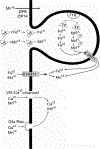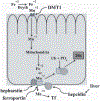Manganese homeostasis and transport
- PMID: 23595673
- PMCID: PMC6542352
- DOI: 10.1007/978-94-007-5561-1_6
Manganese homeostasis and transport
Abstract
The review addresses issues pertinent to Mn accumulation and its mechanisms of transport, its neurotoxicity and mechanisms of neurodegeneration. The role of mitochondria and glia in this process is emphasized. We also discuss gene x environment interactions, focusing on the interplay between genes linked to Parkinson's disease (PD) and sensitivity to Mn.
Figures



Similar articles
-
Manganese homeostasis in the nervous system.J Neurochem. 2015 Aug;134(4):601-10. doi: 10.1111/jnc.13170. Epub 2015 Jun 16. J Neurochem. 2015. PMID: 25982296 Free PMC article. Review.
-
Genetic risk for Parkinson's disease correlates with alterations in neuronal manganese sensitivity between two human subjects.Neurotoxicology. 2012 Dec;33(6):1443-1449. doi: 10.1016/j.neuro.2012.10.009. Epub 2012 Oct 22. Neurotoxicology. 2012. PMID: 23099318 Free PMC article.
-
Manganese exposure exacerbates progressive motor deficits and neurodegeneration in the MitoPark mouse model of Parkinson's disease: Relevance to gene and environment interactions in metal neurotoxicity.Neurotoxicology. 2018 Jan;64:240-255. doi: 10.1016/j.neuro.2017.06.002. Epub 2017 Jun 20. Neurotoxicology. 2018. PMID: 28595911 Free PMC article.
-
Manganese and its role in Parkinson's disease: from transport to neuropathology.Neuromolecular Med. 2009;11(4):252-66. doi: 10.1007/s12017-009-8083-0. Neuromolecular Med. 2009. PMID: 19657747 Free PMC article. Review.
-
Manganese-Induced Parkinsonism and Parkinson's Disease: Shared and Distinguishable Features.Int J Environ Res Public Health. 2015 Jul 6;12(7):7519-40. doi: 10.3390/ijerph120707519. Int J Environ Res Public Health. 2015. PMID: 26154659 Free PMC article. Review.
Cited by
-
Manganese enhances DNA- or RNA-mediated innate immune response by inducing phosphorylation of TANK-binding kinase 1.iScience. 2022 Oct 13;25(11):105352. doi: 10.1016/j.isci.2022.105352. eCollection 2022 Nov 18. iScience. 2022. PMID: 36325059 Free PMC article.
-
Influence of surfactant-tailored Mn-doped ZnO nanoparticles on ROS production and DNA damage induced in murine fibroblast cells.Sci Rep. 2020 Oct 22;10(1):18062. doi: 10.1038/s41598-020-74816-0. Sci Rep. 2020. PMID: 33093462 Free PMC article.
-
Divalent metal content in diet affects severity of manganese toxicity in Drosophila.Biol Open. 2024 Jan 15;13(1):bio060204. doi: 10.1242/bio.060204. Epub 2024 Jan 5. Biol Open. 2024. PMID: 38117005 Free PMC article.
-
Acute manganese exposure impairs glutamatergic function in a young mouse model of Alzheimer's disease.Neurotoxicology. 2023 Mar;95:1-11. doi: 10.1016/j.neuro.2023.01.002. Epub 2023 Jan 5. Neurotoxicology. 2023. PMID: 36621467 Free PMC article.
-
Association of Maternal Plasma Manganese with the Risk of Spontaneous Preterm Birth: A Nested Case-Control Study Based on the Beijing Birth Cohort Study (BBCS) in China.Nutrients. 2023 Mar 15;15(6):1413. doi: 10.3390/nu15061413. Nutrients. 2023. PMID: 36986144 Free PMC article.
References
MeSH terms
Substances
Grants and funding
LinkOut - more resources
Full Text Sources
